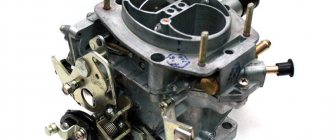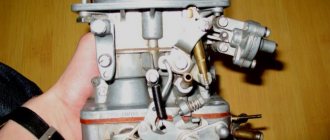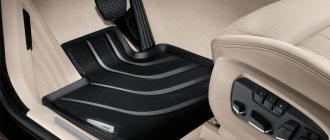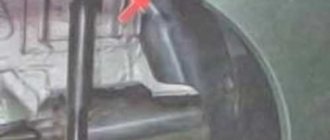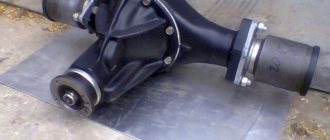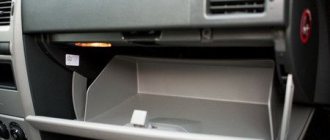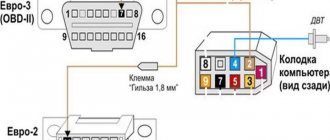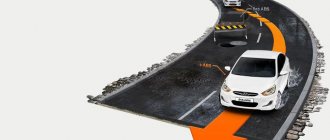Hi all! Reversing with non-working lights, especially at night, can be fatal for the driver of a faulty car and the cars moving behind. You need to understand that if the reverse light is not on, this is a serious problem that needs to be fixed.
The only question is to find the reason for such a situation. If the car's reverse light suddenly stops working, it is recommended to immediately begin diagnostics.
There are several potential problems. Once you find out exactly why the light does not turn on, you can take appropriate measures to eliminate the problem.
Possible reasons
If the reverse lamps do not turn on when shifting into reverse gear, whether it is manual or automatic, you need to look for the reason.
The light must be on. This will not only result in a fine, but can also lead to a serious accident or accident.
- Sensor malfunction
. It is also a reverse switch, limit switch or frog. This controller is quite reliable and durable. But still, the possibility of its breakdown cannot be ruled out. Especially if the car was hit from behind, the headlight was broken and the lights were changed; - Burnt out light bulb
. Or maybe everything is outrageously banal. Over time, the light bulb has used up its resource, and therefore no longer works. It will have to be replaced; - Fuse
. Also, the signal may disappear if the sensor responsible for these lights burns out. This is a fuse link that burns out when the permissible voltage is exceeded. Since this fuse is responsible for several devices at once in most cars, in parallel with the reverse gear, other lamps, dashboard lights, etc. may not light; - Open circuit
. Here pins can break off, wires can fray, and more; - Oxides and corrosion
. Formed in places where the contacts of the circuit leading to the rear lights are connected; - Ground contact
. If the ground is bad, reverse gear may not function. This is also one of the reasons why the brake lights on a car do not light up.
Unlike the situation when the lamp is constantly on, there are many more potential causes.
But still, the most common problem is the failure of the reverse switch. It is also called a frog.
What tasks does the tail light perform?
There is hardly a single motorist who can do without driving in reverse. In order for such movements to be as safe and comfortable as possible in situations with insufficient road illumination: in the evening, at night, in foggy or rainy weather, it is necessary to ensure that the reversing lights work properly at full power, do not malfunction or are broken.
The main function that these lighting devices should perform is illuminating the road while driving in reverse gear. Of course, in addition to their main task, these devices also act as signalers that notify other drivers on the road that you plan to reverse. Often, car owners are faced with the need to install additional reverse lamps, since those that come with the basic configuration of the car simply cannot cope with the responsibilities assigned to them at the required level.
Location
The location of the switch or frog largely depends not on the make and model of the car, but on the transmission with which the vehicle is equipped.
If it is a manual transmission, then the switch will be installed directly on the gearbox housing. When reverse gear is engaged, the switch button is pressed, the frog contacts are bridged, and current flows to the rear lights.
As for automatic transmissions, instead of a standard limit switch (frog), a selector position sensor is used. Depending on the change in the position of the automatic transmission handle, the corresponding signal is transmitted to the power unit control unit, which transmits it to the unit that controls the light.
How to replace reverse lights?
Replacing lamps in rear lighting depends on the type of car. For example, on a Lada Kalina with a station wagon, you need to unscrew 2 bolts holding the lamp in the opening of the tailgate. Then the housing is forcefully removed from the mounting socket (the design provides additional plastic clamps) and the cartridge is removed along with the wiring. On cars with a sedan body, to remove the courtesy light, you need to fold back the flap on the trunk trim and unscrew the fastening nuts with a long-head wrench.
On a VAZ-2105 or 2107, the rear light is covered with a plastic cover located in the luggage compartment. To dismantle the casing, you need to unscrew the nuts and then remove the printed circuit board with the lamps from the lampshade. The faulty element is removed from the socket for replacement, and at the same time the condition of the tracks and contacts is visually checked. Detected oxides must be removed.
On the Kia Rio sedan, you need to remove the handle on the trunk lid, and then partially dismantle the trim, which is attached to the pistons. After bending the casing, access to the flashlight opens; to remove the cartridge, you need to turn the element counterclockwise. The lamp is removed from the socket by the bulb (no thread is provided); the lamp body is marked with a marking indicating the type and power of the lamp.
Checking the functionality of the sensor
Replacing the fuse is not difficult. But checking the condition of all wiring, ringing it and replacing it if necessary is a much more difficult task.
If we talk about restoring the functionality of the reverse lamps with our own hands, then we mainly have to deal with the switch.
To check it you need to do the following:
- remove the rear lamp switch chip;
- turn on the ignition;
- Using a piece of wiring, close the contacts of the sensor and the reverse gear to each other.
If at the same time the lamp lights up, then the reason lies directly in the limit switch.
In this situation, the simplest and most logical solution would be to replace a completely faulty sensor. Indeed, on many cars, replacing it is impractical, too complicated and virtually useless. It is not always possible to restore the functionality of the device. Although there are a number of examples when the sensor was simply disassembled, the contacts were cleaned, and everything returned to normal operation.
It is very difficult to say how long the restored switch will work. This could be for many years, or just a few days.
If everything is fine with the frog, then you will have to ring the circuit and look for the area where the voltage disappears. For these purposes, you will need to use a test light or a multimeter. The task is not for beginners, since we are talking about electrical circuits and working with car electrical systems. Here, for many, it will be more profitable and safer to turn to specialized specialists.
Place of the switch in the light switching circuit
On cars with manual transmission, voltage to the lamps when reversing is supplied through a limit switch (the so-called frog), which is screwed directly into the gearbox housing. When reverse gear is engaged, the switch button is pressed inside the gearbox. The contacts inside the “frog” bridge, and current begins to flow to the lamps.
On the circuit diagram for turning on the reversing lights, we can see that on the VAZ 1118 Kalina, the current from the battery through the ignition switch (No. 2) is supplied to fuse F1. Passing through the fuse that protects the switching circuit, “+” goes to the limit switch (No. 10). The contacts are in a normally open state and close only when reverse gear is engaged. Thus, current begins to flow to the light bulbs. The second contact of the lamps is connected to the “–” battery through the common ground contact of the lamps.
On cars with automatic transmission, the role of the limit switch lies with the selector position sensor. Information about changing the location of the gearshift knob is transmitted to the engine ECU, the light control unit.
How to check the "frog"
- Remove the headlight switch chip.
- Turn on the ignition.
- Using a small piece of wire, connect the contacts of the reverse gear sensor connector to each other.
If the reverse lights are on, then the problem is in the “frog”. Some drivers disassemble the switches, clean the contacts, after which the device continues to work properly. It is up to you to judge the appropriateness of such measures. But keep in mind that on many cars (including VAZ models) the limit switch is located below the oil level in the gearbox. We recommend simply replacing the power sensor. To minimize oil loss, jack up the car on the side where the end switch is installed.
On some cars, the reversing lights do not light up due to incomplete activation of the limit switch. The problem can be solved by installing a thinner washer under the “frog”. To make sure that the switch is working, check with a multimeter in ohmmeter mode whether the contacts close when you press the button.
Checking the circuit
The essence of diagnosing the reason why the reverse lights do not work comes down to identifying the section of the circuit where the voltage is lost. To do this, you can use a regular control light. Continuity testing is done with an ohmmeter, so you need to know how to use a multimeter.
You can start checking directly from the limit switch connector. Turn on the ignition. Connect one contact of the control light to an unpainted metal part in contact with the body, and the second to the “+” connector.
- If power comes in, check the reverse sensor.
- If after installing the “jumper” in the connector the lights do not light up, then the problem is in the section of the wire circuit going from the connector to the lights. Ring the wire to the point where it divides into light bulbs on the left and right sides. Most likely, the reason is the break.
To find the pinout of connectors, light contacts, and wire colors, be sure to study the electrical diagram of your model and vehicle configuration.
VAZ 2107 fuse box: injector
In modern VAZ 2107 models with injection engines, there is also an additional block with fuses and relays, which is installed under the glove compartment in the car. Its main purpose is to control the activation of the electric fuel pump, electric fan, and also the main relay.
The figure below shows an additional block with relays and fuses for VAZ 2107 vehicles with injection engines.
Additional relay block VAZ 2107
Diagram of an additional relay and fuse block for VAZ 2107
Deciphering the diagram of the additional relay and fuse block VAZ 2107
- fuse protecting the power circuits of the main relay;
- main relay;
- fuse protecting the constant power supply circuit of the controller;
- a fuse protecting the electric fuel pump relay circuit;
- fuel pump relay;
- electric fan relay;
- diagnostic connector.
There are also a number of relays that are necessary to ensure the operation of the equipment:
- The brush drive relay is located under the dashboard.
- Starter relay, location to the right of the mudguard.
- Turn, ignition, alarm relays are located under the dashboard.
- The fog light fuse is installed next to the radio receiver under the plugs.
- The fuse for the headlight cleaner is located in the electrical wiring directly at the wiper drive.
For ease of maintenance and detection of failure of circuits in the electrical equipment of the car in case of malfunctions not related to the operation of fuses and relays, an electrical extended diagram of the operation of fuses and relays in a VAZ 2107 car is used, shown in the figure below (click on the picture to enlarge)
VAZ 2107 fuse box diagram Explanation of the fuse box diagram
Burnt out lamps
One of the most common problems is a burnt out lamp. To check this, remove the light bulb from the holder and connect it to the battery terminals with a short wire. If the light comes on, then the fault must be looked for at another point in the electrical circuit.
First, check that the light bulb socket and electrical terminals are clean and bright. If there are any signs of corrosion, clean the socket with wet and dry paper, then reinstall the bulb and retest.
A burnt out light bulb is the most common cause
If the reverse light still does not come on, the fuse may have blown. Also, everything indicates a blown fuse if two reversing lights are constantly on. In this case, a replacement will be needed. Fortunately, getting to the fuse box where they are located will not be too difficult for you.
Checking the electrical wiring
If the current does not reach the lamp socket, you should check the rest of the electrical circuit in reverse order.
- Check your repair manual for the color and route of the reversing wires.
- Probe each wire along its entire length.
- In most cases the wire will disappear into the cable where you can't reach it.
- In this case, you should be extremely careful, because you risk damaging the working wire.
- Once you have identified the faulty section of the wire, remove it and install a piece of new wire in its place.
Important! Be sure to provide high-quality insulation at the wire connection points. The quality of the insulation primarily determines the reliability of the contact and the safety of the driver. You can also eliminate the possibility of a short circuit.
Video - Reverse gear does not light up on VAZ 2108, 2109, 21099. We are looking for the reason
Because You are not logged in. To come in.
Because you are not a trusted user (phone number is not verified). Enter and confirm your phone number. Read more about trusts.
Because The topic is archived.
Replacing the fog light fuse
Proper operation of the fog lights is ensured by a fuse, which is located separately from the fuse box. Its location in a VAZ 2107 car is under the console central panel, next to the fog light button on the panel next to the radio.
To carry out work to check or replace the fog lamp circuit fuse, perform the following sequence of operations:
- Turn off the car's power;
- You need to use a screwdriver to disconnect the switches from the console in the place where the radio is installed, ensuring free access;
- Pull out the plastic insert on the console by squeezing it with a screwdriver to gain access to the fog lamp fuse housing.
- Remove the housing and check or replace the fuse.
- Reassemble all the elements and switches in the reverse order to make sure the fog lights are working.
Additional fuses and relays
Location
Additional fuses and relays are installed behind the side trim of the console, secured with two screws, on the right side of the instrument panel.
Circuit breakers
- Canister purge valve
- Vehicle speed sensor
- Oxygen sensor (heating)
- Air flow sensor
- Fuel pump relay
- Fuel pump
- Injectors.
- Main relay (ignition relay)
Source
